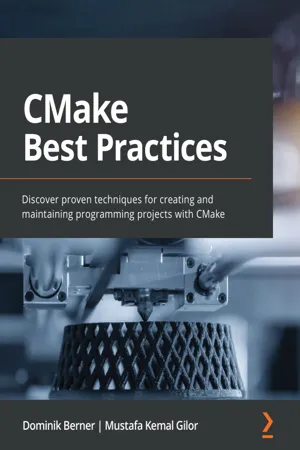
- 406 pages
- English
- ePUB (mobile friendly)
- Available on iOS & Android
CMake Best Practices
About this book
Explore a compendium of tips, tricks, and techniques for leveraging CMake and empowering your software development workflow.Key Features• Understand what CMake is, how it works, and how to interact with it• Discover how to properly create and maintain well-structured CMake projects• Explore tools and techniques to get the most out of your CMake projectBook DescriptionCMake is a powerful tool used to perform a wide variety of tasks, so finding a good starting point for learning CMake is difficult. This book cuts to the core and covers the most common tasks that can be accomplished with CMake without taking an academic approach. While the CMake documentation is comprehensive, it is often hard to find good examples of how things fit together, especially since there are lots of dirty hacks and obsolete solutions available on the internet. This book focuses on helping you to tie things together and create clean and maintainable projects with CMake.You'll not only get to grips with the basics but also work through real-world examples of structuring large and complex maintainable projects and creating builds that run in any programming environment. You'll understand the steps to integrate and automate various tools for improving the overall software quality, such as testing frameworks, fuzzers, and automatic generation of documentation. And since writing code is only half of the work, the book also guides you in creating installers and packaging and distributing your software. All this is tailored to modern development workflows that make heavy use of CI/CD infrastructure.By the end of this CMake book, you'll be able to set up and maintain complex software projects using CMake in the best way possible.What you will learn• Get to grips with architecting a well-structured CMake project• Modularize and reuse CMake code across projects• Integrate various tools for static analysis, linting, formatting, and documentation into a CMake project• Get hands-on with performing cross-platform builds• Discover how you can easily use different toolchains with CMake• Get started with crafting a well-defined and portable build environment for your projectWho this book is forThis book is for software engineers and build system maintainers working with C or C++ on a regular basis and trying to use CMake to better effect for their everyday tasks. Basic C++ and general programming knowledge will help you to better understand the examples covered in the book.
Frequently asked questions
- Essential is ideal for learners and professionals who enjoy exploring a wide range of subjects. Access the Essential Library with 800,000+ trusted titles and best-sellers across business, personal growth, and the humanities. Includes unlimited reading time and Standard Read Aloud voice.
- Complete: Perfect for advanced learners and researchers needing full, unrestricted access. Unlock 1.4M+ books across hundreds of subjects, including academic and specialized titles. The Complete Plan also includes advanced features like Premium Read Aloud and Research Assistant.
Please note we cannot support devices running on iOS 13 and Android 7 or earlier. Learn more about using the app.
Information
Table of contents
- CMake Best Practices
- Contributors
- Preface
- Part 1: The Basics
- Chapter 1: Kickstarting CMake
- Chapter 2: Accessing CMake in Best Ways
- Chapter 3: Creating a CMake Project
- Part 2: Practical CMake – Getting Your Hands Dirty with CMake
- Chapter 4: Packaging, Deploying, and Installing a CMake Project
- Chapter 5: Integrating Third-Party Libraries and Dependency Management
- Chapter 6: Automatically Generating Documentation with CMake
- Chapter 7: Seamlessly Integrating Code Quality Tools with CMake
- Chapter 8: Executing Custom Tasks with CMake
- Chapter 9: Creating Reproducible Build Environments
- Chapter 10: Handling Big Projects and Distributed Repositories in a Superbuild
- Chapter 11: Automated Fuzzing with CMake
- Part 3: Mastering the Details
- Chapter 12: Cross-Platform Compiling and Custom Toolchains
- Chapter 13: Reusing CMake Code
- Chapter 14: Optimizing and Maintaining CMake Projects
- Chapter 15: Migrating to CMake
- Chapter 16: Contributing to CMake and Further Reading Material
- Assessments
- Other Books You May Enjoy